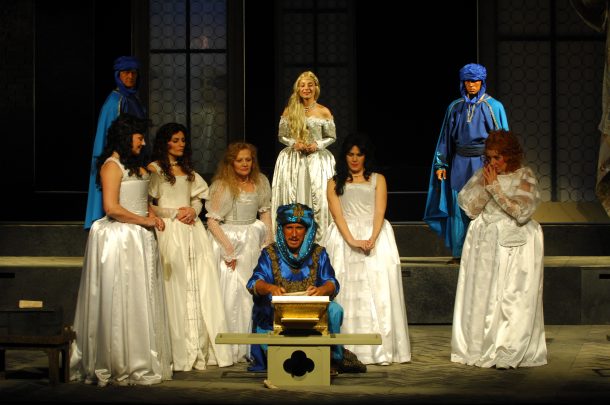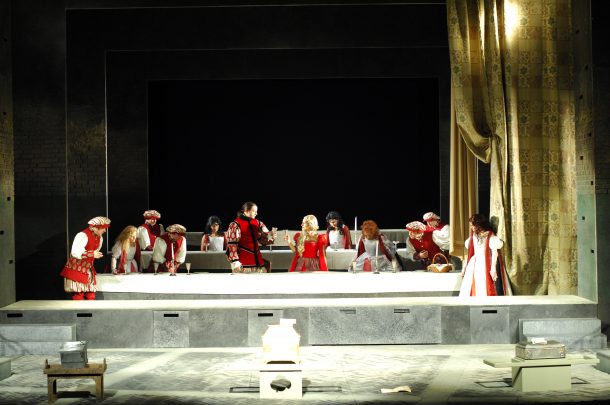The latest of Shakespeare’s plays to be staged at the Croatian National Theatre (CNT) in Osijek is The Merchant of Venice. Painfully contemporary in its theme and character motivation and at the same time humorous and smooth, The Merchant returned to the CNT after eighty-nine years of absence. This play, in which the liveliness of the Renaissance spirit alternates between tragedy and comedy, intertwined with love, vengeance and forgiveness, was directed by Robert Raponja, with costume design by Jasmina Pacek, set design by Darko Petrović, music by Massimo Brajković, and stage movement by Alen Čelić.
The director’s vision respects the original text in time, space and action. Only minor dramaturgical moves were made, consisting of small and precise interventions in characters and scenes that do not “damage” the original. On the contrary, they contribute to the fluidity of the scenes and emphasize various situations in which it is possible to intensify the comic elements in characters through acrobatics, gestures, physical theatre, running, jumping, and fighting—using the entire stage space and thus respecting the conventions of Shakespearean theatre.
The visual components of the show are impressive and complementary to the director’s idea of respecting the original. Petrović’s set design is faithful to Venetian architecture, mathematically precise and representative of a mixture of the conventions of the English Restoration and French Neoclassicism in all of their wealth. The stage also possesses four levels of depth on which various scenes take place and effects occur between these levels as well: a gondola sailing by, balconies, windows, sails of ships—again making use of the whole stage. These levels also reduce the duration of the performance because there are scenes that take place simultaneously on multiple levels. The visual highlight is Jasmina Pacek’s costumes. She created over 100 different costumes characterized by flawless and precise details from Shakespeare’s time. Besides the visual effect, her costumes also define the state and relationships of the characters in each scene: for example, in a scene showing the celebration of Bassanio’s winning over Portia’s love, red is the dominating costume color; when Portia is alone, her costume is predominantly white, signifying purity and innocence.

The Merchant of Venice at the Croatian National Theatre. Photo: Damir Rajle.
In concordance with the logic of the genre of comedy and the conventions of Shakespeare’s time, Raponja introduced two new scenes: Shylock’s baptism, to amplify the religious note and notion of forgiveness, and the final scene in which Shylock makes peace with his daughter and son-in-law Lorenzo. By doing this, Raponja affirms the play as a comedy in which all of the plots are resolved at the end and all of the characters are reconciled (even Shylock, the primary antagonist, is forgiven). This is further emphasized by social confirmation in the form of marriage.
The heart of the performance is actor Boro Stjepanović in the role of Shylock—precise in actions, delicate in gestures, exact in verse, energetic and alive on the stage. His acting skills and experience enable him to transition with ease from comedy to tragedy and vice versa, leaving the audience breathless. Similarly skilled in all elements of their performance are Davor Panić (Antonio) and Sandra Lončarić Tankosić (Portia), and equally valuable are the creations of Miroslav Čabraja (Gratiano) and newcomers Vladimir Tintor (Salerio), Duško Modrinić (Prince of Morocco and Prince of Aragon), Petra Blašković (Nerissa) and Aljoša Čepl (Lorenzo). Guest reinforcements from the Academy of Arts in Osijek are a pleasant surprise, as always, in the form of students and professors who, in smaller but important roles, amaze with the energy they demonstrate.
It is also important to stress that the team behind this great project is actually composed of professionals from CNT Osijek and former students, current students, and professors from the Academy of Arts in Osijek. The director, costume designer, choreographer, and several actors, all from the Academy of Arts in Osijek, combined their theoretical knowledge with the practical and joined forces to create one of the best productions of a Shakespearean play that has been seen in Croatia in recent years. As the second largest state-funded theatre in Croatia and with the Academy of Arts in its vicinity, CNT Osijek is living proof that collaboration between academies and theatres is necessary, showing how it leads to the strengthening of both the theatre and the academy and their repertoire.
Aesthetically mesmerizing and accurate down to the smallest detail, with precise direction and skillful acting, the performance was a great success. But the real significance lies in the fact that the director did not fall under the influence of mainstream directorial convention in which the classics are merely appropriated in order to turn them into largely incomprehensible successions of images. Raponja creates an extraordinary production by honoring the play’s author and original conventions, and this approach was wholeheartedly embraced by audience and experts, simultaneously proving Shakespeare’s importance and timelessness even after 400 years.

The Merchant of Venice at the Croatian National Theatre. Photo: Damir Rajle.
To what can this success be attributed? The answer lies in the tradition of the Croatian National Theatre, which is more than 100 years old, and in the even older German legacy. The history of Osijek, located in eastern Croatia, as a multicultural center in the heart of Central Europe dates back to 1687 when, with the Habsburg dynasty in power, the army of the Austro-Hungarian Empire banished the Turks from Fort Esseg. Given the geographical location of Osijek and the possibility of renewed penetration by the Turks, the Habsburg dynasty decided to turn the city of Osijek into a stronghold for the Empire’s defense. In order to further strengthen the defense, the city was populated with Austrian and German residents, traders, artisans, clerks, and more, which led to the German language becoming the official administrative language, eventually extending to all spheres of life in Osijek. Austro-Hungarian settlers and soldiers were soon followed by German theatre companies (in the middle of the eighteenth century) which spread the German word, affirmed German identity, entertained audiences, and provided material gain for the companies’ actors and directors.
The German theatre companies filled their function in Osijek (as well as the rest of Croatia) until the second half of the nineteenth century and were in fact responsible for bringing the European way of living to Croatia in all fields of society. In the nineteenth century there was an evident increase in awareness of national identity and as a result the first Croatian National Theatre was founded in the Croatian capital, Zagreb. Soon this idea spread in Croatia, gaining ground in Osijek, which eventually resulted in the decline of the influence of the German theatre and the founding of the second Croatian National Theatre in Osijek, on 7 December 1907.
The Croatian repertoire comprised Croatian and German dramatists and German translations of foreign dramatists (mostly English and French), which were then translated into Croatian. It was only when awareness of Croatian national identity began to increase that theatre began to professionalize and was increasingly perceived as an educational ground for the Croatian language. Theatres started to acquire plays in the original languages and translate them into Croatian around 1918. Special care was placed on classics like Shakespeare, whose works were part of the repertoire from the very first days of the Croatian National Theatre in Osijek: its inaugural performance, held on 13 October 1909, was Taming of the Shrew.
Staging Shakespeare’s work after the great success of its initial breakthrough became a tradition, and there was almost no season without a Shakespearean play, or even two, in the repertoire. Not even a disaster such as the Homeland War (the Croatian War of Independence, 1991–95) managed to prevent the staging of Hamlet on 21 December 1990. The life of the Croatian National Theatre in Osijek was violently disrupted on 16 November 1991 when it was bombed by Serbian aggressors, severely damaging the building. During more than 100 years of activity (with breaks in the late twenties, mid-forties and the beginning of the nineties), the Croatian National Theatre in Osijek staged ten different Shakespearean plays thirty-five times over the course of 105 seasons:
- Othello: six times (1912, 1920, 1923, 1937,1947, 1967)
- Hamlet: five times (1911, 1936, 1942, 1951, 1991)
- Romeo and Juliet: four times (1912, 1937, 1956, 2000)
- Taming of the Shrew: four times (1909, 1944, 1962, 1989)
- Twelfth Night: four times (1926, 1930, 1964, 1997)
- The Merchant of Venice: three times (1913, 1923, 2012)
- Macbeth: three times (1916, 1980, 2004)
- A Midsummer Night’s Dream: three times (1921, 1933, 1956)
- King Lear: two times (1925, 1928)
- The Merry Wives of Windsor: one time (1971)
Taken together, the combination of long tradition, the legacy of the German theatre, a high-quality ensemble, and collaboration with the Academy of Arts as a source of young energy and “old” wisdom are the sources of CNT Osijek’s success. Premiering on 27 January 2012, The Merchant of Venice reaffirmed, not only the capacity of the Croatian National Theatre in Osijek to deal with one of the world’s greatest playwrights, but also the value of the 100-year-old tradition of successfully staging Shakespeare’s plays.
Alen Biskupović, Assistant Professor in the field of theatre studies and a theatre critic. He graduated from the Faculty of Humanities and Social Sciences in Osijek in 2006 and in 2014 obtained a PhD degree in the field of Humanities with the doctoral thesis Drama Theatre Criticism in Daily Osijek Newspaper from 1902 to 1945. He has taught various courses on the history of drama and theatre at the Academy of Arts in Osijek since 2008 and works as a theatre critic for different journals and web pages, such as Kazalište.hr (Theatre.hr), Republika (The Republic), and Hrvatsko glumište (Croatian Theatre). He is the editor-in-chief of The Journal for Arts and Culture Artos, and acts as an editor for several theatrological editions.
European Stages, vol. 7, no. 1 (Fall 2016, Special Issue: Shakespeare in Europe, 2016)
Editorial Board:
Marvin Carlson, Senior Editor, Founder
Krystyna Illakowicz, Co-Editor
Dominika Laster, Co-Editor
Kalina Stefanova, Co-Editor
Editorial Staff:
Cory Tamler, Managing Editor
Mayurakshi Sen, Editorial Assistant
Advisory Board:
Joshua Abrams
Christopher Balme
Maria Delgado
Allen Kuharsky
Bryce Lease
Jennifer Parker-Starbuck
Magda Romańska
Laurence Senelick
Daniele Vianello
Phyllis Zatlin
Table of Contents:
- Some Quadricentennial Shakespeare in Germany by Marvin Carlson
- Tiago Rodrigues’s Antony and Cleopatra by Manuel García Martínez
- Amleto: An Opera Rediscovered by Katrin Hilbe
- Coping With the Greatest for Over One Hundred Years by Alen Biskupović
- The Art of Sharing Shakespeare: Emil Boroghină, a Romanian Sorcerer by Maria Zărnescu
- Shakespeare’s Villains and Modern Politicians in Latvia by Edīte Tišheizere
- A Queen for a King! Tom Lanoye’s Königin Lear at Schauspiel Frankfurt by Katrin Hilbe
- The Tempest: Magical Ballet Where East Meets West by Sepideh Shokri Poori
- “The Ukrainian Play”: Macbeth Ritualized by Vlad Troitskyi by Daria Moskvitina
- Les Kurbas’s Tradition in Ukrainian Shakespeare Productions by Nataliya Torkut
Martin E. Segal Theatre Center:
Frank Hentschker, Executive Director
Marvin Carlson, Director of Publications
Rebecca Sheahan, Managing Director
©2016 by Martin E. Segal Theatre Center
The Graduate Center CUNY Graduate Center
365 Fifth Avenue
New York NY 10016



